by John Semlak | Jun 12, 2017 | #ONTHISDAY
 Thomas Willett: New York City’s first mayor
Thomas Willett: New York City’s first mayor
In 1664 British ships sailed into the harbor of New Amsterdam, the capital of the Dutch colony New Netherland. But the city’s residents, the majority of whom where not Dutch, put up little resistance. Many hoped the British would be better rulers than the Dutch West India Company. The city was named after James Stuart, the Duke of York.
On June 12 1665 the merchant Thomas Willett was appointed the city’s first ever mayor. He had lived in New Netherland for years and was friendly to many of the Dutch businessmen who remained in the city and still held great influence. He served a one year term and was reappointed mayor again in 1667. Willett remained in New York until 1673 and retired in Swansea in modern day Massachusetts. He’s buried in Little Neck Cemetery in East Providence, Rhode Island. The headstone still survives.
The current New York City mayor, Bill de Blasio, is the 109th mayor of the city. In 1908 the FDNY named a fireboat the Thomas Willett after the city’s first mayor. The boat was in service until 1959.
 The fireboat Thomas Willett in the foreground.
The fireboat Thomas Willett in the foreground.
by John Semlak | May 31, 2017 | #ONTHISDAY
 The original Madison Square Garden in 1879 (courtesy NYPL)
The original Madison Square Garden in 1879 (courtesy NYPL)
On May 31st, 1879, a gala was held to officially open the first building to be called .Madison Square Garden’. It was located at the corner of Madison Square Park at 26th Street and Madison Avenue, where today the New York Life building by Cass Gilbert stands. It was originally built in 1874 and named the Great Roman Hippodrome by P.T. Barnum, and later called Gilmore’s Garden. It was then given the name which still exists today by the site’s owner William Kissam Vanderbilt.
The first Madison Square Garden hosted boxing matches, including one with John L Sullivan, track-and-field events, Elks conventions, the Westminster Kennel Club Dog Show, and more. The Madison, an Olympic track cycling discipline, derives its name from the Garden.
The building was demolished in 1889 and replaced at the same location by the second Madison Square Garden, an architectural masterpiece of Stanford White. That building was demolished in 1926, though the name lived on at a different location at 8th Avenue between 49th and 50th Streets. Today’s Madison Square Garden is at 33rd Street and 8th Avenue. The current stadium is the 4th building to bear the name and its third location.
by John Semlak | Feb 6, 2017 | #NYCSports, #ONTHISDAY
Babe Ruth, perhaps baseball’s greatest ever player, was born on this day in 1895 in Baltimore, Maryland. He defined the early greatness of the Yankees and established it as baseball’s greatest club. His transfer from the Boston Red Sox also helped define one of baseball’s greatest rivalries.
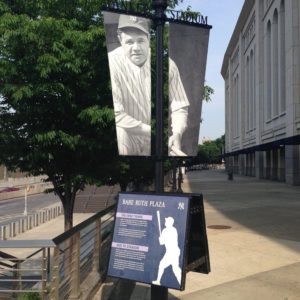
Babe Ruth Plaza outside Yankee Stadium
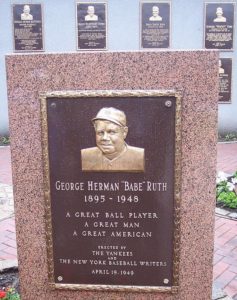
Plaque at Monument Park
The most relevant place to experience Babe Ruth in New York of course is Yankee Stadium, even though it’s not the Yankee Stadium that Babe Ruth played at. The original was torn down into in 2008. The new Yankee Stadium contains the Yankee Stadium museum which contains player memorabilia and Monument Park, and open air museum featuring retired numbers as well as plaques honoring famous Yankees. Unfortunately Monument Park is closed in February but access it is included in tickets to Yankee games.
You can also visit the Ansonia apartment building, where he lived for a time, at 72nd and Broadway. You can have an ale at McSoreley’s on 7th Street, a bar he drank at. You can also visit his grave at the Gate of Heaven Cemetery in Westchester County north of the city. It can be accessed by train from Grand Central; the stop is Mount Pleasant. A number of other baseball players are buried there.
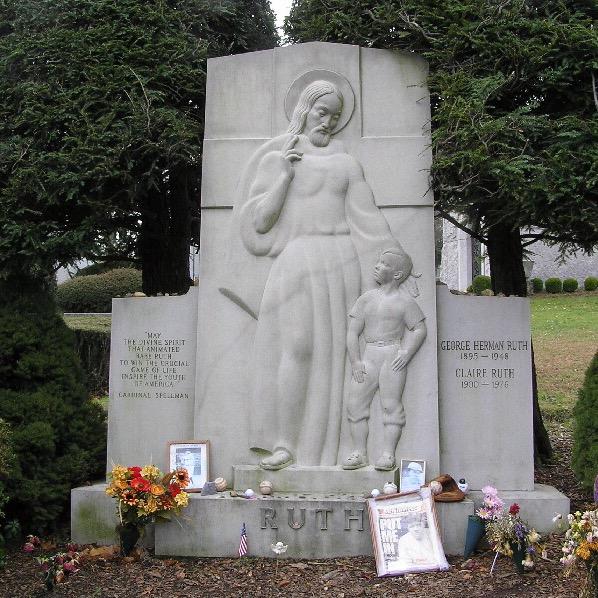
Ruth’s grave at Gate of Heaven Cemetery
by John Semlak | Jan 16, 2017 | #ONTHISDAY, #SportsHistory
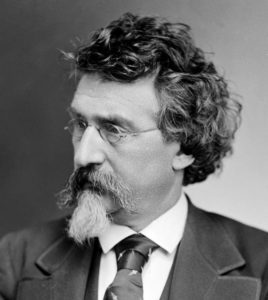 Brady in 1875
Brady in 1875
On this day in 1896, pioneering photographer Mathew Brady died. Brady was famous for his famous studio portrait of Abraham Lincoln used in the 1860 general election, as well as his photographs of the American Civil War. He and his assistant Alexander Gardner photographed Lincoln nearly two dozen times.
 Brady’s 1860 photo of Lincoln
Brady’s 1860 photo of Lincoln
In the 1850s, Mathew Brady was one of the most famous photographers in the world. In 1851 he won a medal at the Great Exhibition in London. He had studios in New York and Washington and his studio in New York was also a tourist attraction with portraits of many dignitaries from around the world. On February 27th 1860, then presidential candidate Abraham Lincoln stepped into his studio on Broadway for a photograph just before his speech at Cooper Union. This photograph was widely published during the general election campaign of 1860. Brady would move to Washington and began to document the American Civil War in photographs. Using travelling darkrooms, Brady and his assistants traveled to battlefields and took photographs of the scene.
 Brady’s grave at the Congressional Cemetery in Washington DC. The year of his death is incorrect.
Brady’s grave at the Congressional Cemetery in Washington DC. The year of his death is incorrect.
Despite his fame, Brady’s fortunes declined after the war. Anticipating future sales of his Civil War photographs, Brady invested in having photo plates made, but found far fewer buyers than anticipated. He went into debt and began to suffer from depression. He died in poverty in 1896 at Presbyterian Hospital in Manhattan. His funeral was financed by veterans of the New York 7th Infantry, and he was buried at the Congressional Cemetery in Washington DC.
by John Semlak | Jul 9, 2016 | #NYCHistory, #NYCParks, #ONTHISDAY
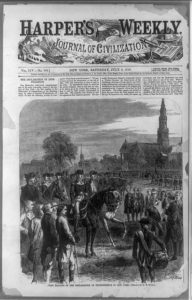
Illustration of George Washington reading the Declaration of Independence in New York on July 9th 1776. St. Paul’s Chapel, which still stands, is in the background right. The image by A.R. Waud appeared on July 9th, 1870 in Harper’s Weekly.
On July 9th 1776, George Washington read aloud the Declaration of Independence which had been read first 5 days earlier in Philadelphia. He read it in front of his troops in the area then called the Commons, where today’s City Hall Park is. The spot is commemorated with an inscription on the pavement inside City Hall Park.
 Inscription on the pavement in City Hall Park commemorating Washington’s reading of the Declaration of Independence, unfortunately faded badly.
Inscription on the pavement in City Hall Park commemorating Washington’s reading of the Declaration of Independence, unfortunately faded badly.
Inspired by Washington’s reading of the Declaration, soldiers and patriots marched down to Bowling Green Park and tore down a statue to King George III, which had been erected only six years earlier to try to improve support for the monarchy in the city. The statue was melted down and used to make bullets used by the Continental Army. Today, a fence surrounds the park what was originally installed to protect the
statue of George. It had crowns on its lampposts which were sawed off by the patriots.
 Painting by Johanes Adam Simon Oertel depicting the pulling down of the statue of King George the III at Bowling Green Park. This painting hangs at the New-York Historical Society.
Painting by Johanes Adam Simon Oertel depicting the pulling down of the statue of King George the III at Bowling Green Park. This painting hangs at the New-York Historical Society.
New York City was at the time Rebel territory but would be abandoned by Washington later that year and held by the British for the remainder of the war. Washington would return to New York at the end of the war to officially liberate the city on November 25th, 1783, when the final British troops evacuated the city.
by John Semlak | Apr 30, 2016 | #AmericanRevolution, #ONTHISDAY
On April 30th, 1789, George Washington was inaugurated president of the United States on the balcony of the Federal Hall Building on Wall Street, New York City. At that time, New York was the capital of the United States (until 1791). The building, which served as the capital building of the US government, was torn down in 1812. The current building at the site (26 Wall Street) was built in 1842 as the US Customs House and is now the Federal Hall National Memorial. A model of the original building is pictured, along with the stone where Washington stood for his inauguration. Federal Hall is now open to the public and contains many exhibits of this period of US history, including the Washington Bible. It is open to the public and admission is free of charge.

 Thomas Willett: New York City’s first mayor
Thomas Willett: New York City’s first mayor The fireboat Thomas Willett in the foreground.
The fireboat Thomas Willett in the foreground. The original Madison Square Garden in 1879 (courtesy NYPL)
The original Madison Square Garden in 1879 (courtesy NYPL)


 Brady in 1875
Brady in 1875 Brady’s 1860 photo of Lincoln
Brady’s 1860 photo of Lincoln Brady’s grave at the Congressional Cemetery in Washington DC. The year of his death is incorrect.
Brady’s grave at the Congressional Cemetery in Washington DC. The year of his death is incorrect.
 Inscription on the pavement in City Hall Park commemorating Washington’s reading of the Declaration of Independence, unfortunately faded badly.
Inscription on the pavement in City Hall Park commemorating Washington’s reading of the Declaration of Independence, unfortunately faded badly. Painting by Johanes Adam Simon Oertel depicting the pulling down of the statue of King George the III at Bowling Green Park. This painting hangs at the New-York Historical Society.
Painting by Johanes Adam Simon Oertel depicting the pulling down of the statue of King George the III at Bowling Green Park. This painting hangs at the New-York Historical Society.